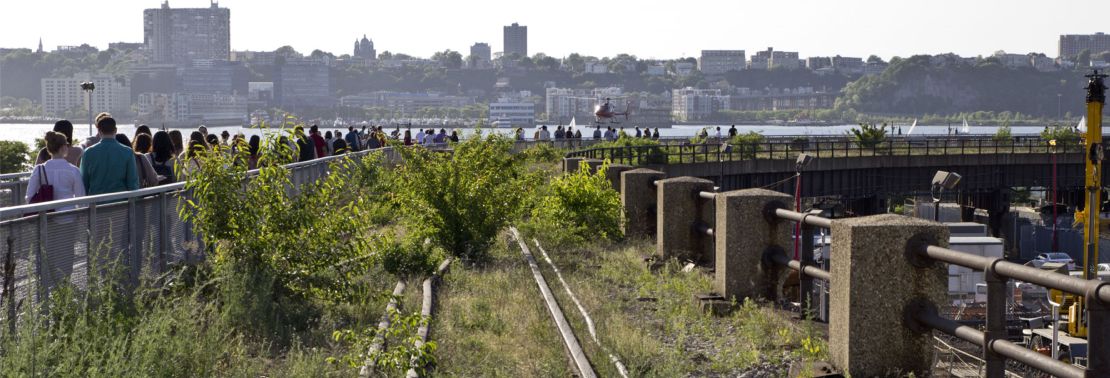A Comparison of the Three Phases of the High Line, New York City: A Landscape Architect and Photographer’s Perspective
“A Comparison of the Three Phases of the High Line, New York City: A Landscape Architect and Photographer’s Perspective” compares Phase One with Phase Two, and describes what is proposed for Phase Three. Design features to be reviewed include the walk system, seat furnishings, plantings, signage and graphics, water feature and drinking fountains, public art, lighting, maintenance and irrigation, and Phase 3. The author also offers suggestions on economic impacts, restrictions and user activities, sustainability, and studies/research.
Originally, due to the length and photo essay nature of the contribution, the series was presented approximately every few weeks in 14 parts between 2013 and 2015; to ensure background information, the Series Introduction is repeated on all.
Part 12 – Studies/Research
By Steven L. Cantor, Landscape Architect – Originally Posted October 31, 2014
All Photos © Steven L. Cantor Unless Otherwise Noted
Series Introduction

Phase One High Line on July 15, 2009.
Designed by landscape architect James Corner of Field Operations, architect Ricardo Scofidio of Diller Scofidio + Renfro with planting design by Piet Oudolf, the High Line, the remarkable linear park built on an abandoned railroad viaduct in New York City, has been enormously popular.
The design team anticipated how well green roof technology would function and adapt to the viaduct since it could handle at once the huge weight of several fully-loaded trains carrying heavy tonnage. As an intensive green roof, it has very few structural load limits which would curtail use. At peak use times there can be lines of pedestrians waiting to enter with as many as 20,000 visitors per day on weekends.[1]
The High Line has won numerous awards, and in particular several as a green roof, for example, in 2013 and 2010 from the American Society of Landscape Architects, Green Roofs for Healthy Cities in 2011, and in 2010 from the International Green Roof Association. This is a rare public project in which the success of the initial phase contributed to a high level of funding for subsequent phases.
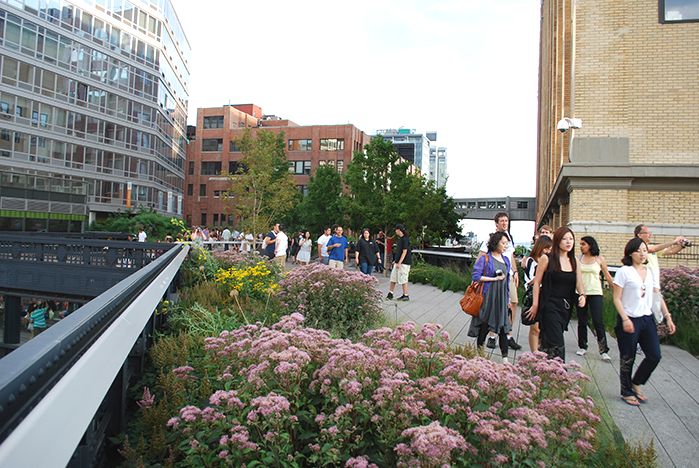
7.16.11.
The High Line has benefited from intense scrutiny as a result of lectures in which the designers were questioned; public hearings, media critiques in newspapers, journals, and blogs; lobbying from specific organizations, such as the Rainforest Coalition; and comments from city government and other public officials.
Improvements or adjustments were implemented to some design elements of the first phase, and significant modifications were done in the second phase. Are these changes aesthetic, appropriate and ethical, and are they consistent with the goals of sustainability? Is the High Line a sustainable design?
Part 12: Studies/Research Discussion
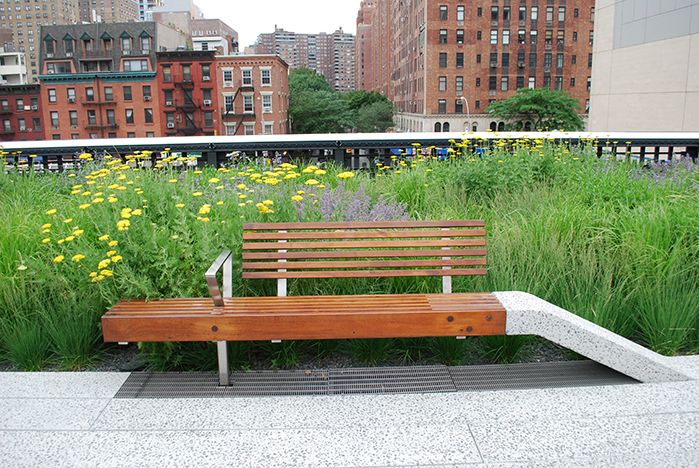
Above: Iconic wood bench on 6.16.11. Below: The finishes are wearing off on 11.30.13.
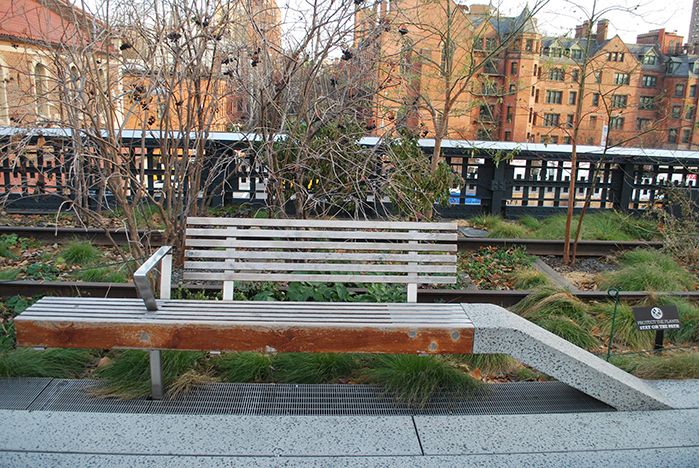
Why and how is it that some benches have weathered much better than others?
Given its diversity and popularity, there are many potential subjects for research on the High Line. In part such projects would be dependent on documenting differences in how some materials have weathered and withstood intense use compared to others, for example, teak or ipe, compared to composite materials.
Initially the first phase had little irrigation, so a comparison to phase two which was irrigated, would have been useful. However, the High Line is primarily a park and urban destination for thousands of pedestrians and tourists, and the designers are often tweaking elements to improve them, so it’s probably difficult to keep accurate records or maintain different materials or systems, when improvements are needed immediately. Whereas a more standardized project with three distinct phases might lend itself to controlled experiments and comparisons, the dynamic state of the High Line makes this difficult.
At earlier points in its development, the High Line was described as being built in three phases, as if each phase would be distinct with a different series of highlights. In more recent years, the discussion has changed to “sections,” as if each is part of a continuous whole. It is perhaps a subtle distinction, yet there is now such an overlap between the character and methods of construction and maintenance between the first two sections, that calling them phases is perhaps no longer accurate.
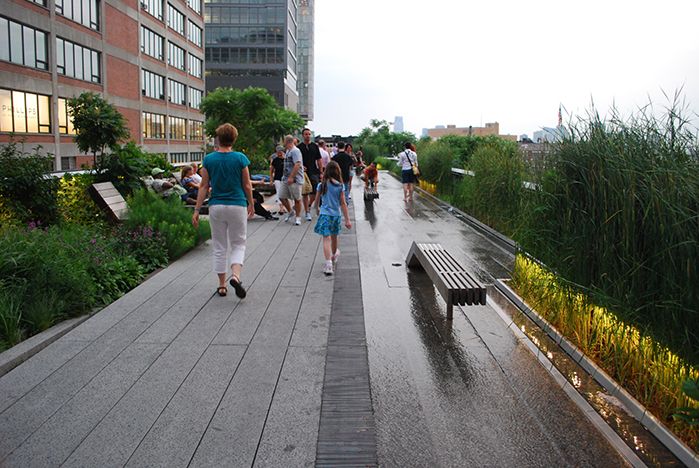
The water feature went through several design concepts before the existing design was implemented of a simple sheet of water flowing over the concrete planks. The redesigned Diller – von Furstenberg Sundeck water feature on 6.10.11.
Blurring of the chronology of changes in materials used for benches, for example, or the different designs used for the water feature makes comparisons more difficult. Similarly, the website for the High Line, which has a wealth of useful information, is constantly being updated, so previous versions of some sections or earlier descriptions of key elements are now revised, making it difficult to appreciate the remarkable sequence of steps which occurred just to create a particular element, much less, the entire design.
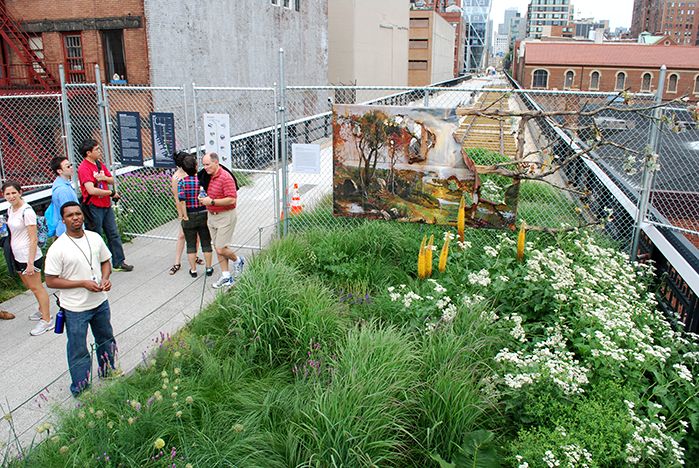
Valerie Hegarty’s Autumn on the Hudson Valley with Branches: the temporary end of Phase One. 6.12.10.
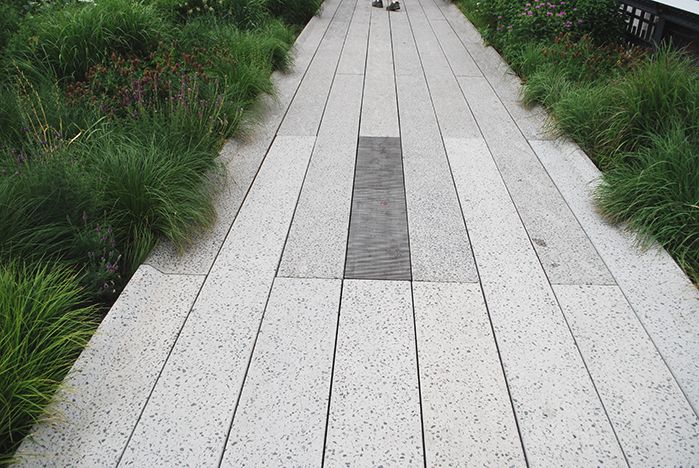
Looking south where Phase One work meets the newer Phase Two work, one can see a darker tone to the Phase One pavements since they have experienced a longer period of continual pedestrian use; at the same time, the designers’ goal is to create a seamless integration between the first and second phase work. 6.16.11.
One significant element is missing, a description of costs and information about particular manufacturers or suppliers. It would be helpful for city planners and designers alike to know in detail what the construction and maintenance costs are of each section, as well as the manufacturer and/or supplier of key components of the green roofs system, lighting, etc.
As previously noted (see Part 8 – Maintenance & Irrigation Discussion), the maintenance costs per acre of the High Line are the highest, by a significant margin, of any New York City park. At the same time, the New York Post is not the most reliable source of such data, but it should be widely available to help planners and designers understand how to create the best designs at the lowest costs, and how to aim for a balance between innovative designs and maintenance costs. For example, a helpful study might evaluate maintenance costs in terms of the cost per park user rather than per acre of park land. Given the huge number of visitors to the High Line, the maintenance costs might seem modest.
Dependent on having accurate information available, it would be a remarkable contribution to ongoing green roof research to evaluate which plants survived the best, which have struggled and which died. On my walks on the High Line I’ve occasionally talked to some of the gardeners doing planting and maintenance, and although the plantings for the most part have been effective and adapted well to the harsh environment, there are some exceptions. It would be helpful to document such situations.
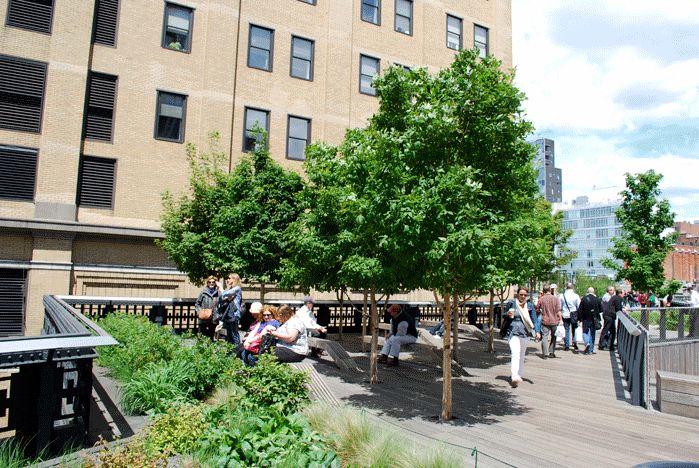
Grove of three-leafed (or three flowered) maples, Acer triflorum, at the Tenth Avenue Square; 5.11.12. How have they survived and grown compared to other species of native or non-native trees?
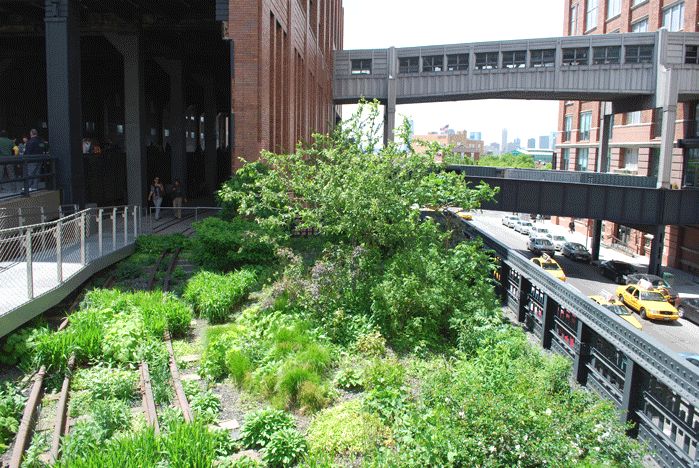
Northern Spur; 5.11.12. How have these plantings fared? Is their survival and growth rate better or worse than areas where more horticultural varieties are used?
I recall one species of willow, for example, that was planted in the Chelsea Thicket which grew like Godzilla, and had to be severely pruned back or possibly removed altogether. A related area of study would be how the non-native species have interacted with the native species? Have some in either category tended to dominate? Have the natives out-performed the non-natives or vice versa? Have there been more problems with insect or disease pests on some plants more than others?
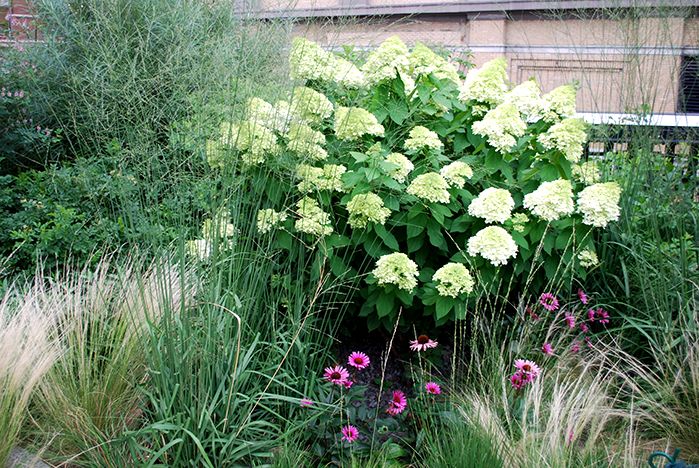
Non-native panicle hydrangeas provide a beautiful accent amidst Calamagrostis grasses. 7.16.11.
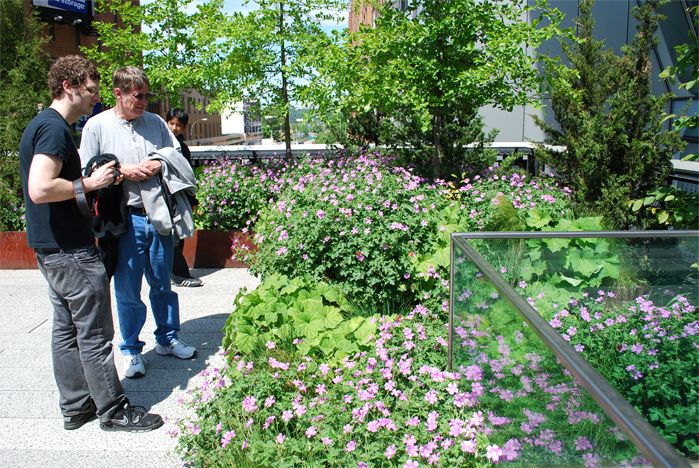
Non-native flowering Max Frei bloody cranesbill, Geranium sanguineum ‘Max Frei’ and native green alum root or coral bells, Heuchera sp. 5.11.12.
A range of studies have been undertaken that compare real estate values before and after the High Line was built, as well as the number of visitors and many different economic impacts. [13] As the third phase finishes construction and the massive development of the Hudson Rail Yards is completed, there will be many opportunities for further analysis. An environmental impact assessment of the entire High Line, the Hudson Rail Yards and West Chelsea might yield valuable results and insights.
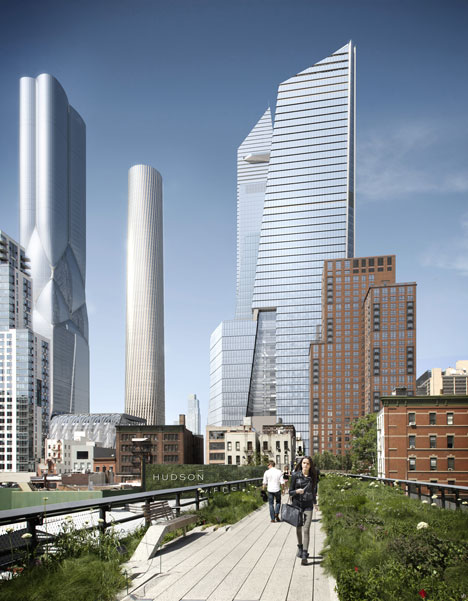
Before development of Hudson Yards. Image courtesy ©Related-Oxford.
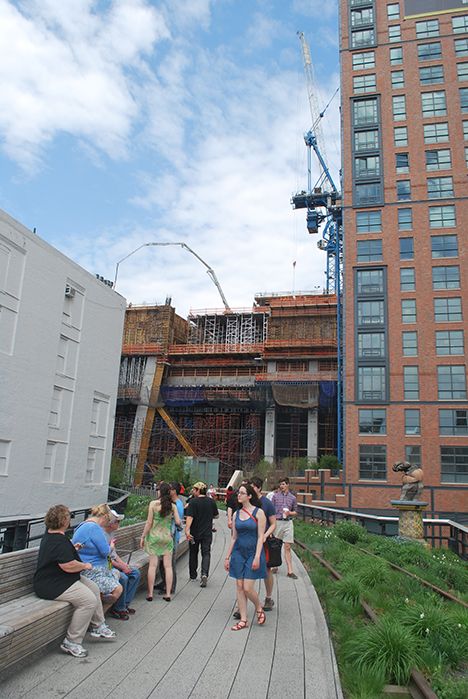
During construction of Hudson Yards, viewed from The High Line; 5.12.14.
Finally, a detailed sustainable design study would be useful, to create a clear assessment of what specific aspects of the design save and conserve resources and energy, and which may overly tax them to a point that the future of the park is put at risk.
Just as the High Line itself has set off a range of new urban design and real estate development beyond what one might have imagined when it was first conceived, so does it represent an opportunity for continued study and research.
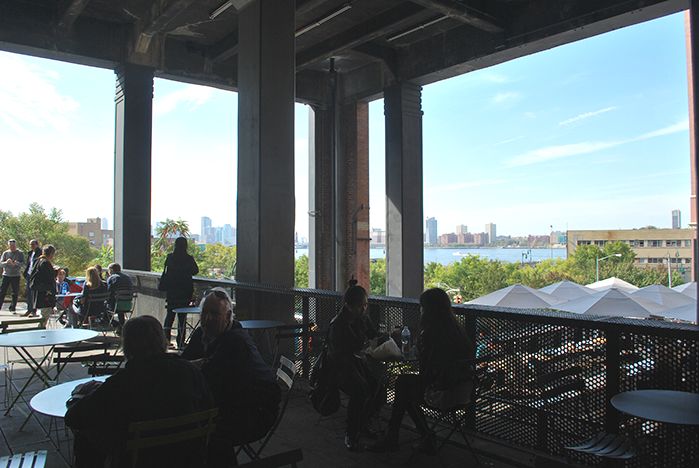
10.14.13.
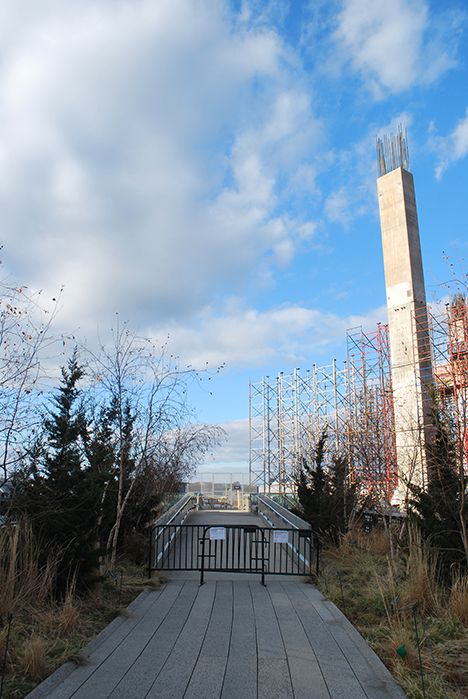
A view along current northern end of Phase Two of the High Line, with a structural column for 10 Hudson Yards in the background on 1.12.14.
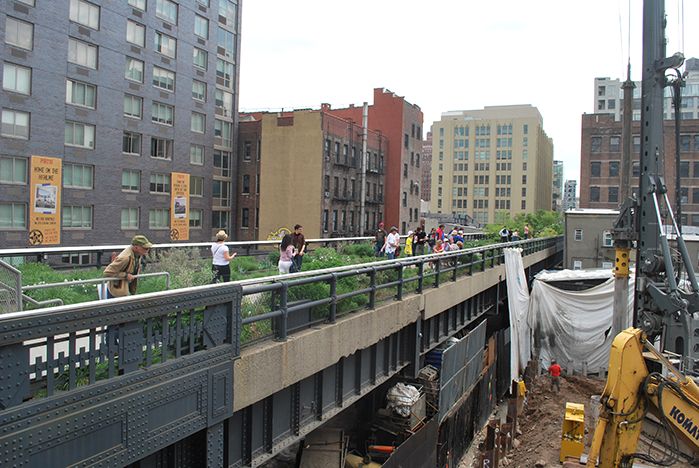
The entire corridor is now lined with new real estate developments, some of which dwarf the High Line. The initial catalyst for urban design is now absorbed in a much larger entity. 5.12.14.
That’s it for now. I hope that these different sections of text and images of the High Line will generate discussion.
Come back next time for Part 13, Phase Three As-built Discussion of “A Comparison of the Three Phases of the High Line, New York City: A Landscape Architect and Photographer’s Perspective.”
Steven L. Cantor
Photos © Steven L. Cantor are available for individual purchase.
Cumulative 14-part “A Comparison of the Three Phases of the High Line, New York City: A Landscape Architect and Photographer’s Perspective” Series End-notes
1. Ulam, Alex. “Back on Track,” Landscape Architecture Magazine. Volume 99, No. 10, October, 2009, p. 97.
2. http://www.thehighline.org/news/2012/01/24/major-milestone-for-the-high-line-at-the-rail-yards
3. http://www.thehighline.org/sustainability
4. http://www.thehighline.org/design/planting
5. Ulam, Alex. “Back on Track,” Landscape Architecture Magazine. Volume 99, No. 10, October, 2009, p. 97 and 105-106. He refers to an article in the New York Post.
6. David, Joshua, Reclaiming the High Line, a project of the Design Trust for Public Space with Friends of the High Line. Karen Hock, editor, (New York, Ivy Hill Corporation and others, 2002). p.7.
7. http://www.thehighline.org/about/ask-a-gardener
8. http://untappedcities.com/2013/10/17/live-blog-from-2013-mas-summit-for-nyc-day-1/
http://untappedcities.com/2012/04/26/partners-in-preservation-the-high-line-section-3/
http://untappedcities.com/2013/11/13/spur-the-third-section-of-the-high-lines-crown-jewel-a-nest-in-the-sky/ (by Bhushan Mondkar)
9. http://www.thehighline.org/sustainability and http://www.thehighline.org/about/faq
10. http://www.thehighline.org/about/faq
11. Cantor, Steven. Green Roofs in Sustainable Landscape Design. (New York, WW Norton, 2008). p. 34 (Several additional definitions are provided. It is possible to measure sustainable elements precisely, from carbon footprints to other calculations, but that is beyond the scope of this discussion.)
12. http://www.thehighline.org/sustainability
13. http://ticcih.org/wp-content/uploads/2013/04/ticcihbulletin55.pdf is just one example, from the International Committee for the Conservation of the Industrial Heritage.
Publisher’s Note:
See Steven L. Cantor’s ENTIRE 14-part “A Comparison of the Three Phases of the High Line, New York City: A Landscape Architect and Photographer’s Perspective” Series.
Steven L. Cantor, Landscape Architect
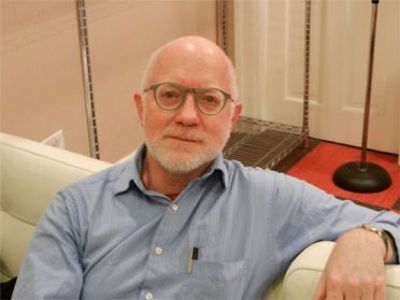
Photo by Thomas Riis.
Steven L. Cantor is a registered Landscape Architect in New York and Georgia with a Master’s degree in Landscape Architecture from the University of Massachusetts, Amherst. He first became interested in landscape architecture while earning a BA at Columbia College (NYC) as a music major. He was a professor at the School of Environmental Design, University of Georgia, Athens, teaching a range of courses in design and construction in both the undergraduate and graduate programs. During a period when he earned a Master’s Degree in Piano in accompanying, he was also a visiting professor at the College of Environmental Design at the University of Colorado, Boulder. He has also taught periodically at the New York Botanical Garden (Bronx) and was a visiting professor at Anhalt University, Bernberg, Germany.
He has worked for over three decades in private practice with firms in Atlanta, GA and New York City, NY, on a diverse range of private development and public works projects throughout the eastern United States: parks, streetscapes, historic preservation applications, residential estates, public housing, industrial parks, environmental impact assessment, parkways, cemeteries, roof gardens, institutions, playgrounds, and many others.
Steven has written widely about landscape architecture practice, including two books that survey projects: Innovative Design Solutions in Landscape Architecture and Contemporary Trends in Landscape Architecture (Van Nostrand Reinhold, John Wiley & Sons, 1997). His book Green Roofs in Sustainable Landscape Design (WW Norton, 2008), provides definitions of the types of green roofs and sustainable design, studies European models, and focuses on detailed case studies of diverse green roof projects throughout North America. In 2010 the green roofs book was one of thirty-five nominees for the 11th annual literature award by the international membership of The Council on Botanical & Horticultural Libraries for its “outstanding contribution to the literature of horticulture or botany.”
Steven’s most recent book is Professional and Practical Considerations for Landscape Design (Oxford University Press, 2020) where he explains the field of landscape architecture, outlining with authority how to turn drawings of designs into creative, purposeful, and striking landscapes and landforms in today’s world.
He has been a regular attendee and contributor at various ASLA, green roofs and other conferences in landscape architecture topics.
In recent years Steven has had more time for music activities, as a solo pianist and accompanist. In 2011 he performed a solo piano program at the Winter Rhythms festival at Urban Stages Theater. He’s a regular performer at musicales hosted in Chelsea and other settings in Manhattan. On August 25, 2013, Leonard Bernstein’s birthday, he performed with Stephen Kennedy Murphy a program of excerpts from the composer’s MASS and Anniversaries.
Steven joined the Greenroofs.com editorial team in December, 2013 as the Landscape Editor. In February, 2015 he completed his 14-part series “A Comparison of the Three Phases of the High Line, New York City: A Landscape Architect and Photographer’s Perspective.”
 Greenroofs.comConnecting the Planet + Living Architecture
Greenroofs.comConnecting the Planet + Living Architecture
